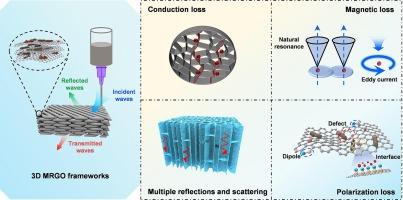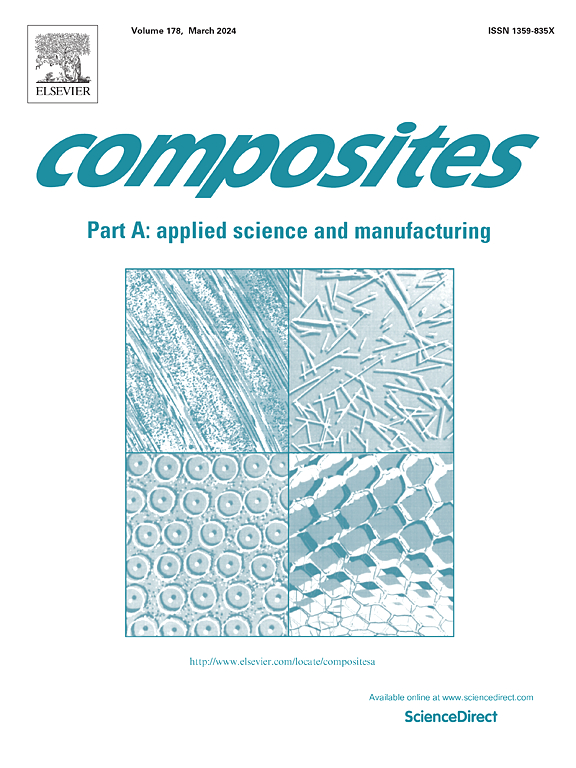3D printing of graphene frameworks decorated with magnetic components for enhanced electromagnetic interference shielding
IF 8.1
2区 材料科学
Q1 ENGINEERING, MANUFACTURING
Composites Part A: Applied Science and Manufacturing
Pub Date : 2024-11-13
DOI:10.1016/j.compositesa.2024.108588
引用次数: 0
Abstract
Three-dimensional (3D) printed graphene frameworks with structural designability and compositional tunability offer new opportunities for electromagnetic interference (EMI) shielding applications. However, advanced EMI shielding materials with customizable structures and magnetic responsiveness remain a challenge. Herein, we construct lightweight and structurally controllable 3D reduced graphene oxide frameworks decorated with magnetic components (MRGO frameworks) via 3D printing technology to tailor EMI shielding properties. By adjusting the preparation conditions of the MRGO frameworks, such as inter-filament spacing, composition, and pyrolysis temperature, the graphitization degree and transmission paths are influenced, enabling electrical conductivity and magnetic property, and ensuring excellent EMI shielding performance. Specifically, the average EMI shielding effectiveness of the MRGO framework in the K-band and Ka-band is 44.95 dB and 53.90 dB, respectively. Furthermore, the 3D MRGO frameworks follow a reflection-dominated EMI shielding mechanism. This work provides insights into the development of EMI shielding materials through structural design and compositional optimization.

三维打印装饰有磁性元件的石墨烯框架,增强电磁干扰屏蔽能力
具有结构可设计性和成分可调性的三维(3D)打印石墨烯框架为电磁干扰(EMI)屏蔽应用提供了新的机遇。然而,具有可定制结构和磁响应性的先进 EMI 屏蔽材料仍然是一项挑战。在此,我们通过三维打印技术构建了轻质且结构可控的三维还原氧化石墨烯框架,并用磁性成分进行了装饰(MRGO 框架),以定制 EMI 屏蔽性能。通过调整 MRGO 框架的制备条件,如丝间距、成分和热解温度,影响石墨化程度和传输路径,实现导电性和磁性,确保优异的 EMI 屏蔽性能。具体来说,MRGO 框架在 K 波段和 Ka 波段的平均 EMI 屏蔽效果分别为 44.95 dB 和 53.90 dB。此外,三维 MRGO 框架遵循反射为主的 EMI 屏蔽机制。这项工作为通过结构设计和成分优化开发 EMI 屏蔽材料提供了启示。
本文章由计算机程序翻译,如有差异,请以英文原文为准。
求助全文
约1分钟内获得全文
求助全文
来源期刊

Composites Part A: Applied Science and Manufacturing
工程技术-材料科学:复合
CiteScore
15.20
自引率
5.70%
发文量
492
审稿时长
30 days
期刊介绍:
Composites Part A: Applied Science and Manufacturing is a comprehensive journal that publishes original research papers, review articles, case studies, short communications, and letters covering various aspects of composite materials science and technology. This includes fibrous and particulate reinforcements in polymeric, metallic, and ceramic matrices, as well as 'natural' composites like wood and biological materials. The journal addresses topics such as properties, design, and manufacture of reinforcing fibers and particles, novel architectures and concepts, multifunctional composites, advancements in fabrication and processing, manufacturing science, process modeling, experimental mechanics, microstructural characterization, interfaces, prediction and measurement of mechanical, physical, and chemical behavior, and performance in service. Additionally, articles on economic and commercial aspects, design, and case studies are welcomed. All submissions undergo rigorous peer review to ensure they contribute significantly and innovatively, maintaining high standards for content and presentation. The editorial team aims to expedite the review process for prompt publication.
 求助内容:
求助内容: 应助结果提醒方式:
应助结果提醒方式:


